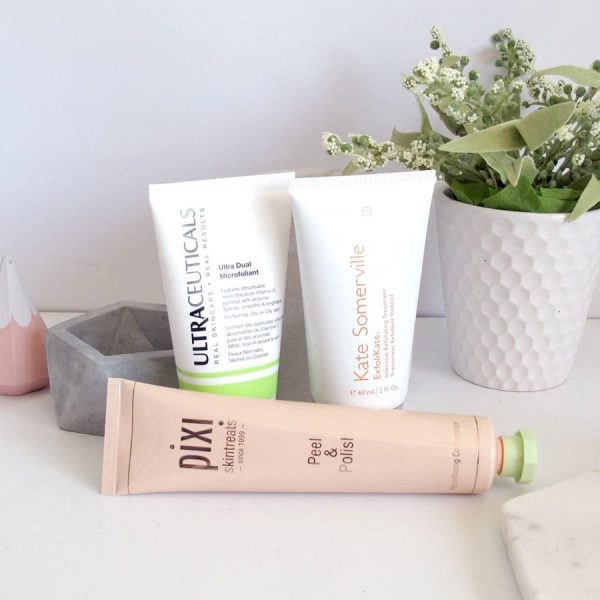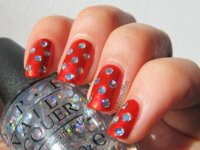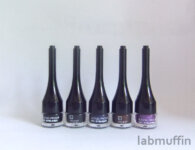As you may know from my guides to exfoliation, I’m obsessed with helping my skin desquamate. Unlike a lot of other skincare addicts, I don’t have a favourite type of exfoliation – I’ve found that my skin responds best when I have all three of the major exfoliation types (physical, chemical and enzyme) in my routine. That’s why I’ve been really excited about the appearance of more combination exfoliation products on the market, and today I’m reviewing three of them: Pixi Beauty Peel & Polish, Kate Somerville ExfoliKate Intensive Exfoliating Treatment, and Ultraceuticals Ultra Dual Microfoliant.
What are the benefits and drawbacks of combination exfoliants?
There are a few benefits to having all the different types of exfoliation in the one product:
Firstly, it’s a massive time saver, especially since the individual products tend to be formulated for use at different stages of your routine: scrubs and enzymes are usually wash-off products that you use after cleanser, while chemical exfoliants are usually leave-on products that you use under moisturisers. These combo products are all rinse-off.
If you have sensitive skin, it means you only have to find one product that your skin can handle.
It’s also good for when you’re trying to play catch-up with your exfoliation and you want to blast your skin with everything at once without crossing over into the frustrating realm of overexfoliation. Having an all-in-one product means you don’t have to try to remember how much of each exfoliant your skin can handle when paired with other products. This is always a doozy because the number of combos you can make increases exponentially with more products. If you have 3 products it gives you 7 possible combinations, if you have 4 products you have 15 combinations… if you have 7 products (which sounds like a lot, but isn’t all that unusual if you count things like washcloths and sponges) it gives you a headache-inducing 127 combinations. And that doesn’t include other considerations like application order, other skincare treatments you might use them with, and the state of your skin before treatment.
The biggest downside to having a combination product is that it limits your ability to customise your skincare routine. For example, you can’t choose to use enzymes without using the acid at the same time, and you can’t choose to leave the acid on for longer (excluding the scrub isn’t usually an issue since you can just move the product around less).
It also makes it harder to work out which type of exfoliation your skin likes the most (though chances are it’s the whole package).
Onto the reviews:

Pixi Peel & Polish
Exfoliating ingredients:
- 6% lactic acid (chemical – AHA)
- polylactic acid (physical – microbeads)
- beraclay light red (physical – clay)
- papaya extract (enzyme – papain)
- sugar cane extract (??? I though this would be glycolic acid, but the packaging suggests that it’s physical)
Price: $24 USD (Amazon) / $37.95 AUD / £26 for 80 mL
Pixi have been on my radar for a long time with their affordable exfoliants like Glow Tonic and Glow Peel Pads, which have 20% glycolic acid. They’ve recently launched in Australia, though as usual there’s an Australian markup making them rather less affordable. Peel & Polish is their newest exfoliant. It has a bit of everything, though I can’t say for sure that all of the ingredients I listed have a large contribution to exfoliation. I’m particularly happy with the fact that they actually state the strength of the lactic acid (6%) – not enough companies do this!
Peel & Polish is a very gentle exfoliant that in my opinion primarily acts as a physical scrub, with a bit of chemical and enzyme action added as a bonus. It contains pleasantly small biodegradable PLA scrubbing beads, and has a highish pH of 4 so it’s unlikely to work as well as a standard leave-on AHA. The effect on my skin was more than I’d get with a comparable scrub though, so the chemical and enzyme ingredients do seem to be working! There are a few other beneficial ingredients in there too like witch hazel and ginseng extract, so you could count it as a mask as well. It has the same cucumber scent as the Glow Tonic.
I think Peel & Polish is a great product for introducing your skin to exfoliation, or as a not-quite-break-day product when you’re trying to let your skin recover but don’t want to stop exfoliating entirely. It’s also good for skin that can’t handle too much chemical exfoliation. However, if your skin likes AHAs, I’d recommend using a separate chemical exfoliant as well. I’ve been applying it before hopping into the shower to rinse it off. It’s recommended that you leave it on your skin for up to 2 minutes, although I’ve left it on for longer with zero stinging. Pixi recommend using it 2-3 times a week.
Ingredients: Water/Aqua/Eau, Lactic Acid, Polylactic Acid, Helianthus Annuus (Sunflower) Seed Oil, Cetearyl Alcohol, Propanediol, Ceteareth-20, Beraclay Light Red, Hamamelis Virginiana (Witch Hazel) Water, Panax Ginseng Root Extract, Carica Papaya (Papaya) Fruit Extract, Saccharum Officinarum (Sugar Cane) Extract, Acer Saccharum (Sugar Maple) Extract, Cucumis Sativus (Cucumber) Fruit Extract, Citrus Aurantium Dulcis (Orange) Fruit Extract, Citrus Limon (Lemon) Fruit Extract, Vaccinium Myrtillus Fruit Extract, Hydroxyethylcellulose, Polyglceryl-3 Cocoate, Butylene Glycol, Maltooligosyl Glucoside, Glyceryl Stearate, PEG-100 Stearate, Caprylic/Capric Triglyceride, Dipentaerythrityl Tri-Polyhydroxystearate, Hydrogenated Starch Hydrolysate, Phenoxyethanol, Caprylyl Glycol, Sodium Hydroxide, Xanthan Gum, Polyglceryl-4 Caprate, Polyglceryl-6 Caprylate, Polyglceryl-6 Ricinoleate, Pentylene Glycol, Sorbic Acid, Hydroxyphenyl Propamidobenzoic Acid, Ascorbyl Palmitate, Benzoic Acid, Tocopherol.
Kate Somerville ExfoliKate Intensive Exfoliating Treatment
Exfoliating ingredients:
- lactic acid (chemical – AHA)
- polyethylene (physical – microbeads)
- papaya extract (enzyme – papain)
- Lactobacillus pumpkin ferment (enzyme)
- salicylic acid (chemical)
- bromelain, papain (enzyme)
Price: $85 USD (Amazon) / $124 AUD (Mecca) / £85 for 60 mL
I’ve heard so much about ExfoliKate, but I was sceptical that a rinse-off product, used at a maximum of 2 minutes twice a week would do much. I was wrong.
ExfoliKate is INTENSE. Even though I’ve been using acids for a long time, it tingled like the start of an in-clinic peel. It’s intended for use in the shower, which is a good idea so you can rinse off the product if it gets too burny.
But – it worked. As much as I’ve a believer in the adage that exfoliants don’t need to hurt to work, I also don’t think that painful treatments are necessarily bad for your skin. This herbal-smelling green paste made my skin noticeably brighter and smoother, and blitzed a bunch of closed comedones that had been nagging me for a while.
I would not recommend this if your skin isn’t used to higher strength AHAs. I can’t find the percentage of lactic acid, but it has a pH of around 3. My skin is pretty acid tolerant (facialists are always surprised when my skin isn’t beet red after treatments), but this still felt like a once-a-fortnight treatment for me. It also contains non-biodegradable microbeads at the time of writing, though I’m hoping they’ll switch soon. While microbeads from cosmetics are probably not as bad for the environment as other sources of microplastic like synthetic clothing and decomposing plastic waste, it seems like an easily substituted ingredient.
Needless to say, ExfoliKate had embedded itself firmly into my skincare routine. I use a very thin film around once a fortnight, and avoid leave-on acid exfoliants for three days afterwards. The obvious downside (apart from potentially overexfoliating and living in regret for a month) is the price, but a little goes a long way and the moisture from the shower helps it spread over your skin. There’s a smaller 15 mL size as well that’s a bit more affordable. I’m a convert.
Ingredients: Water/Aqua/Eau, Lactic Acid, Polyethylene, Glycine Soja (Soybean) Oil, Cetearyl Alcohol, Pectin, Carica Papaya (Papaya) Fruit, Lactobacillus Pumpkin Ferment Extract, Ceteareth-20, Cetyl Alcohol, Glyceryl Stearate, Dehydroxanthan Gum, PEG-100 Stearate, Salicylic Acid, SD Alcohol 40-B, Citrus Aurantium Bergamia (Bergamot) Fruit Oil, Sorbic Acid, Cinnamomum Cassia Leaf Oil, Honey/Mel/Miel, Acetic Acid, Lavandula Angustifolia (Lavender) Oil, Potassium Sorbate, Tocopheryl Acetate, Retinyl Palmitate, Bromelain, Papain, Aloe Barbadensis Leaf Juice, Phenoxyethanol, Geranium Maculatum Oil, Aniba Rosaeodora (Rosewood) Wood Oil, Pogostemon Cablin Oil, Citrus Aurantium Dulcis (Orange) Oil, Linalool, Limonene, Cinnamal, Beta-Carotene (CI 75130), Chlorophyllin-Copper Complex (CI 75810)
Ultraceuticals Ultra Dual Microfoliant
Exfoliating ingredients:
- cellulose (physical – microbeads)
- ascorbic acid (physical – crystals)
- jojoba esters (physical – microbeads)
- bromelain (enzyme)
Price: $79 AUD for 75 mL
Ultraceuticals is one of the few skincare companies that really seems to know what they’re doing in terms of effective formulas. They invest a lot in research and clinical trials – I’m always impressed when I see their presentations. Their products are quite pricey, but it’s hard to complain too much when their prices are comparable to luxury brands with mundane, active-free formulas.
Ultra Dual Microfoliant is a water-free product that contains ascorbic acid (vitamin C) crystals and biodegradable microbeads in a dimethicone base with bromelain (pineapple enzyme). Ascorbic acid is notoriously unstable in most water-based formulas, so this product takes advantage of this fact by letting it dissolve in water and absorb only when it hits your face. The silicone base leaves a protective film on your face, which I’m guessing helps the vitamin C absorb.
I’ve been using this when I’ve forgotten to make my very low-effort DIY vitamin C spray. The main issue I’ve had is that it’s hard to use Ultra Dual Microfoliant with anything else – the dimethicone layer it leaves is pretty robust and doesn’t let other products absorb easily, so my humectant toners don’t do much over it. However, I’ve found that it’s a pretty effective moisturiser on its own so it works nicely on super lazy nights! The other issue I’ve had is that the other microbeads don’t dissolve, so you need to use a washcloth to wipe them off and even then I find stray beads on the edges of my face.
It doesn’t have a pH since it’s a water-free product, but mixed with a small amount of water it ends up being around pH 3. It has a very mild, inoffensive citrus scent.
Ingredients: Cyclopentasiloxane, Dimethicone, Cellulose, Hydrogenated Vegetable Oil, Ascorbic Acid, Dimethicone/Vinyl Dimethicone Crosspolymer, Jojoba Esters, Bromelain, Panthenyl Triacetate, Hydroxyethyl Acrylate/Sodium AcryloyldimethylTaurate Copolymer, Maltodextrin, Hydroxypropylcellulose, Citrus Grandis (Grapefruit) Peel Oil, Citrus Aurantium Bergamia (Bergamot) Fruit Oil, CI 77492, Linalool, Limonene.
Which combination exfoliants have you used? Which ones would you recommend? Let me know in the comments!
These products were provided for editorial consideration. This post also contains affiliate links – if you decide to click through and support Lab Muffin financially (at no extra cost to you), thank you! For more information, see Disclosure Policy.






I totally agree with you on ExfoliKate – I tried a sample of it and it really stung! so much I couldn’t do the full minute or so of exfoliation, I had to rinse off early! From time to time I use the Philosophy micro delivery two-step peel – leaves my skin so baby smooth and it’s so quick!
I need to try the Philosophy product! I actually have it sitting in my bathroom…
I have used chemical and physical exfoliants in combination and so far only one three in one product that Imlike a lot, but use maybe once a fortnight because it is intense. Usually I try to stick to individual products though,mmy skin has been more sensitive since I started using retinol and it is easy to overdo the treatments now.
I hear you on the retinol! I’m almost certain it caused my broken capillaries 🙁
Thanks for the info, very informative! Would you say that Exfolikate is similar to Glamglow’s Flashmud?
Not really – Flashmud is just clay + salicylic acid, while Exfolikate is All Of The Exfoliants.